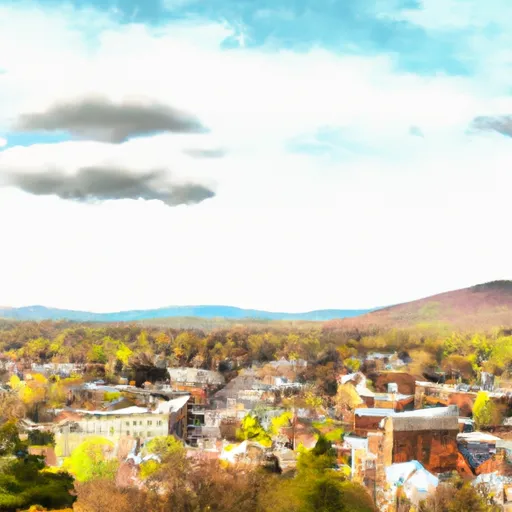-
 Snoflo Premium
Snoflo Premium
Get unlimited access to all our content
With no Ad interruptions! - Start Your Free Trial Login with existing account
Great-Barrington
Eden Index
Climate
8.3
•
Recreation
4.8
•
Community
•
Safeguard
5.0/10

Great Barrington is a small town located in the southern Berkshires of Massachusetts. The climate is characterized by cold winters and warm summers, with an annual precipitation average of around 47 inches. The town is situated on the Housatonic River and its tributaries, which provide a vital source of water for the area. However, the river has been contaminated by PCBs, which has led to restrictions on fishing and swimming in certain areas. Despite this, Great Barrington offers many outdoor recreation opportunities, including hiking in the nearby Beartown State Forest and skiing at the Ski Butternut resort. The town is also home to several parks and trails, such as Lake Mansfield and the Housatonic River Walk.
What is the Eden Index?
The Snoflo Eden Index serves as a comprehensive rating system for regions, evaluating their desirability through a holistic assessment of climate health, outdoor recreation opportunities, and natural disaster risk, acknowledging the profound impact of these factors on livability and well-being.
Climate Health Indicator (CHI): 8.3
Great-Barrington receives approximately
1210mm of rain per year,
with humidity levels near 75%
and air temperatures averaging around
8°C.
Great-Barrington has a plant hardyness factor of
5, meaning
plants and agriculture in this region thrive during a short period during spring and early summer. Most
plants will die off during the colder winter months.
By considering the ideal temperature range, reliable water supplies, clean air, and stable seasonal rain or snowpacks, the Climate Health Indicator (CHI) underscores the significance of a healthy climate as the foundation for quality living.
A healthy climate is paramount for ensuring a high quality of life and livability in a region, fostering both physical well-being and environmental harmony. This can be characterized by ideal temperatures, reliable access to water supplies, clean air, and consistent seasonal rain or snowpacks.
Weather Forecast
Streamflow Conditions
Connecticut Coastal
Area Rivers
Connecticut Coastal
Snowpack Depths
Connecticut Coastal
Reservoir Storage Capacity
Connecticut Coastal
Groundwater Levels
Recreational Opportunity Index (ROI): 4.8
The Recreational Opportunity Index (ROI) recognizes the value of outdoor recreational options, such as parks, hiking trails, camping sites, and fishing spots, while acknowledging that climate plays a pivotal role in ensuring the comfort and consistency of these experiences.
Access to outdoor recreational opportunities, encompassing activities such as parks, hiking, camping, and fishing, is crucial for overall well-being, and the climate plays a pivotal role in enabling and enhancing these experiences, ensuring that individuals can engage in nature-based activities comfortably and consistently.
Camping Areas
| Campground | Campsites | Reservations | Toilets | Showers | Elevation |
|---|---|---|---|---|---|
| Lake Waramaug State Park | 75 | 719 ft | |||
| Copake Falls - Taconic State Park | None | 678 ft | |||
| Beartown State Forest | 12 | 1,614 ft | |||
| Rudd Pond - Taconic State Park | None | 827 ft | |||
| October Mountain State Forest | 47 | 1,021 ft | |||
| Macedonia Brook State Park | 50 | 808 ft | |||
| Point Folly - White Memorial | 45 | 914 ft | |||
| Housatonic Meadows State Park | 100 | 456 ft | |||
| Pittsfield State Forest | 30 | 2,120 ft | |||
| Windmill Hill - White Memorial | 45 | 947 ft |
Nearby Fishing
Nearby Ski Areas
Catastrophe Safeguard Index (CSI):
The Catastrophe Safeguard Index (CSI) recognizes that natural disaster risk, encompassing floods, fires, hurricanes, and tornadoes, can drastically affect safety and the overall appeal of an area.
The level of natural disaster risk in a region significantly affects safety and the overall livability, with climate change amplifying these risks by potentially increasing the frequency and intensity of events like floods, fires, hurricanes, and tornadoes, thereby posing substantial challenges to community resilience and well-being.
Community Resilience Indicator (CRI):
The Community Resilience Indicator (CRI) recognizes that education, healthcare, and socioeconomics are crucial to the well-being of a region. The CRI acknowledges the profound impact of these elements on residents' overall quality of life. By evaluating educational resources, healthcare accessibility, and economic inclusivity, the index captures the essential aspects that contribute to a thriving community, fostering resident satisfaction, equity, and social cohesion.

